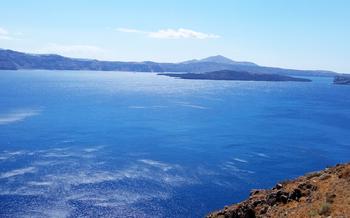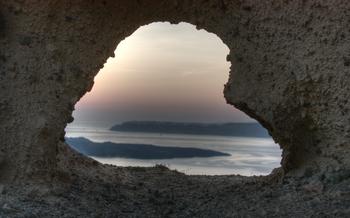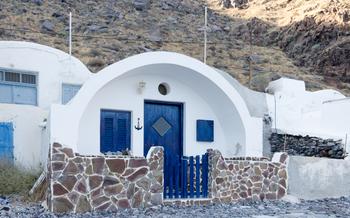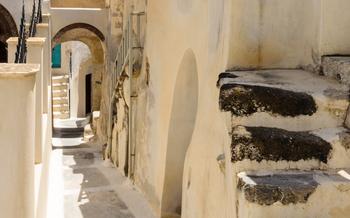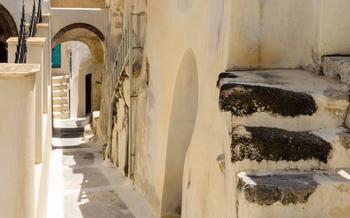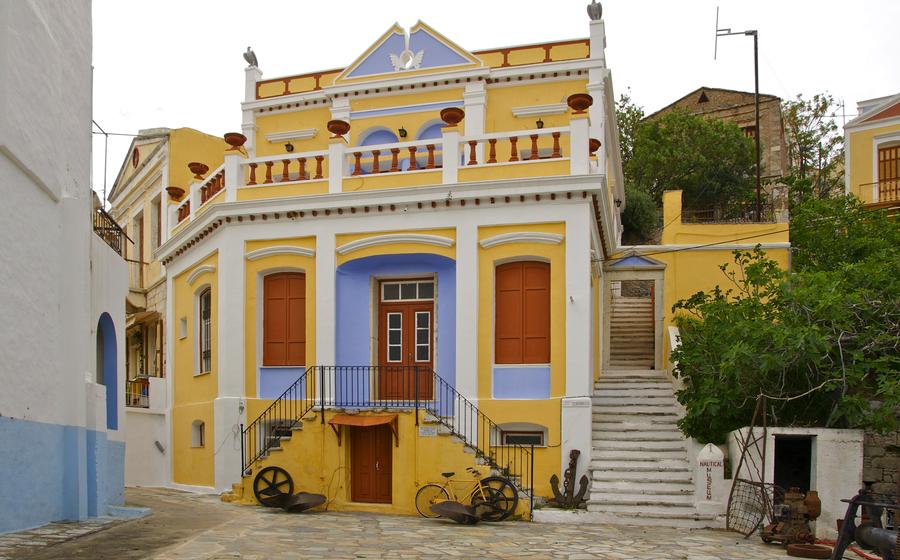
Santorini Nautical Museum
- Santorini Nautical Museum: A Journey Through Maritime History
- Unique Collection of Nautical Artifacts
- Interactive Displays and Educational Exhibits
- The Story of Santorini's Seafaring Heritage
- Ancient Shipwrecks and Underwater Discoveries
- Traditional Greek Boat Building
- The Art of Navigation
- Maritime Legends and Folklore
- Educational Programs and Workshops
- Temporary Exhibitions and Events
- Guided Tours and Multimedia Presentations
- Museum Shop and Souvenirs
- Accessibility for Visitors
- Plan Your Visit
- Insider Tip: Hidden Gem for Maritime Enthusiasts
Santorini Nautical Museum: A Journey Through Maritime History
Nestled amidst the enchanting landscapes of Santorini, the Santorini Nautical Museum stands as a testament to the island's deep-rooted maritime heritage. Established in 1956, this captivating museum takes visitors on an immersive journey through the rich seafaring traditions of the Aegean. Located in the heart of Oia, the museum is housed within a traditional captain's mansion, adding to its historical charm and authenticity. Its convenient location makes it easily accessible for visitors exploring Oia's picturesque streets and offers breathtaking views of the caldera.
Unique Collection of Nautical Artifacts
The Santorini Nautical Museum houses a diverse collection of nautical artifacts that offer a glimpse into the island's rich maritime past. Among the highlights are rare and fascinating exhibits, such as ancient anchors, navigation instruments, and shipbuilding tools. Visitors can learn about the techniques and materials used in traditional Greek boat building, as well as the evolution of boat designs over time.
One of the most intriguing exhibits is a collection of ancient amphorae, which were used for transporting wine and other liquids. These amphorae have been recovered from shipwrecks around the island, and they provide valuable insights into the trading routes and maritime activities of ancient Santorini. Visitors can also see a replica of a Minoan ship, which was built according to ancient designs and techniques. This replica offers a tangible connection to the island's rich seafaring heritage.
Interactive Displays and Educational Exhibits
The Santorini Nautical Museum takes pride in its engaging and interactive displays that cater to visitors of all ages. These exhibits bring the world of maritime history to life, offering an immersive experience that showcases the rich traditions and practices of seafaring. Through hands-on activities, multimedia presentations, and informative panels, visitors can explore the nuances of navigation, shipbuilding, and the daily lives of sailors in ancient Greece.
One of the highlights of the museum is the interactive navigation simulator, which allows visitors to experience the challenges of navigating a ship through ancient sea routes. Using replica instruments and charts, visitors can plot their course, adjust their sails, and navigate through treacherous waters, gaining a deeper understanding of the skills and knowledge required for seafaring in ancient times.
Another popular exhibit is the replica of an ancient Greek trireme, a formidable warship that played a crucial role in ancient naval warfare. Visitors can climb aboard the trireme, examine its intricate construction, and learn about the strategies and tactics used by ancient Greek sailors during battles.
The museum also features a collection of interactive games and puzzles that test visitors' knowledge of maritime history and challenge them to think like ancient seafarers. These games not only provide entertainment but also reinforce the educational value of the museum experience.
Overall, the interactive displays and educational exhibits at the Santorini Nautical Museum offer a captivating and enriching experience, making it an ideal destination for anyone interested in maritime history, ancient Greece, or simply seeking an engaging and educational day out.
The Story of Santorini's Seafaring Heritage
Santorini's maritime history is as rich and captivating as its volcanic landscapes. The island's strategic location in the Aegean Sea made it a natural hub for trade and exploration in ancient times. Excavations on the island have unearthed evidence of settlements dating back to the Neolithic period, indicating early seafaring activities.
During the Bronze Age, Santorini was a thriving center of the Minoan civilization, known for its advanced maritime skills. The Minoans were expert shipbuilders and traders, establishing a vast maritime network that stretched across the Mediterranean. Their ships transported goods such as pottery, olive oil, and wine to far-off lands, contributing to the cultural and economic exchange of the ancient world.
In the Classical period, Santorini became part of the Athenian Empire and played a crucial role in the naval battles of the Peloponnesian War. The island's strategic location and natural harbor made it a valuable asset to the Athenian fleet, providing shelter and supplies for their ships.
Throughout history, Santorini's seafaring heritage continued to flourish. The island's inhabitants became skilled fishermen, sponge divers, and shipbuilders, passing down their knowledge and traditions from generation to generation. Even today, fishing remains an important livelihood for many families on Santorini, and the island's boatyards continue to produce traditional Greek boats using centuries-old techniques.
Ancient Shipwrecks and Underwater Discoveries
The Santorini Nautical Museum showcases a remarkable collection of artifacts and findings from ancient shipwrecks and underwater excavations. These discoveries provide invaluable insights into the maritime history of the region, shedding light on ancient trading routes, ship design, and navigation techniques. The museum houses a variety of shipwreck artifacts, including pottery, tools, weapons, and other personal belongings that were recovered from underwater excavations. These artifacts offer a glimpse into the lives of ancient seafarers and the types of goods that were transported across the Mediterranean Sea.
The museum's collection also features fascinating replicas of ancient ships, providing visitors with an immersive experience of what these vessels looked like and how they were constructed. These replicas are based on detailed research and careful study of ancient shipwrecks, allowing visitors to appreciate the ingenuity and craftsmanship of ancient shipbuilders.
Traditional Greek Boat Building
The Santorini Nautical Museum also delves into the fascinating world of traditional Greek boat building, showcasing the techniques and materials used in constructing these remarkable vessels. Visitors can learn about the different types of boats used in Greece, from the simple fishing boats to the larger trading vessels that once sailed the Mediterranean Sea.
The museum's collection includes a variety of tools and equipment used in boatbuilding, such as axes, adzes, and chisels. Visitors can also see examples of different types of wood used in boat construction, including pine, fir, and cypress.
The museum also highlights the evolution of boat designs over time. From the early days of simple rafts and canoes to the more sophisticated sailing vessels of the Classical period, the museum showcases the ingenuity and creativity of Greek shipbuilders.
Visitors can learn about the various factors that influenced the design of Greek boats, such as the type of cargo they carried, the distance they traveled, and the weather conditions they encountered.
The Art of Navigation
In the realm of ancient seafaring, the art of navigation played a crucial role in guiding mariners across vast and treacherous waters. The Santorini Nautical Museum sheds light on the ingenious methods and instruments employed by ancient Greek sailors to chart their course and find their way back home.
Visitors can marvel at a collection of ancient navigation tools, including astrolabes, compasses, and sextants, which were used to measure the position of the stars, sun, and moon relative to the horizon. Detailed maps and charts, meticulously crafted by hand, offer a glimpse into the intricate knowledge of ancient cartographers who mapped out sea routes and coastal landmarks.
Interactive displays and educational exhibits provide an immersive experience, allowing visitors to simulate the process of celestial navigation and understand how ancient mariners determined their latitude and longitude. The museum also highlights the role of lighthouses and landmarks, which served as crucial navigational aids, guiding ships safely through treacherous waters and into bustling harbors.
Through these exhibits, the Santorini Nautical Museum not only preserves the legacy of ancient seafaring but also inspires a sense of awe and admiration for the ingenuity and resilience of those who dared to conquer the vast and unforgiving sea.
Maritime Legends and Folklore
The Santorini Nautical Museum is not just a repository of historical artifacts; it's also a treasure trove of maritime legends and folklore. These stories, passed down through generations of seafarers, offer a glimpse into the rich cultural tapestry of the island and its deep connection to the sea.
In the museum's exhibits, you'll find tales of brave sailors who battled mythical creatures, gods and goddesses who ruled the waves, and shipwrecks that left behind a legacy of mystery and intrigue. These stories are not just figments of imagination; they're deeply rooted in the experiences and beliefs of the island's seafaring community.
For the ancient Greeks, the sea was a sacred space, home to powerful deities like Poseidon, the god of the sea, and Amphitrite, his wife. Sailors would often make offerings to these gods in the hope of a safe journey and a bountiful catch.
The museum also houses a collection of amulets and talismans that were believed to protect sailors from harm. These objects, often made of bone, metal, or seashells, were thought to possess magical powers and were often worn or carried by seafarers as they ventured out into the unknown.
The stories and legends surrounding the sea are an integral part of Santorini's maritime heritage. They remind us of the deep connection between humans and the sea, and the enduring power of the human imagination in the face of the vast and mysterious ocean.
Educational Programs and Workshops
The Santorini Nautical Museum offers a range of educational programs and workshops designed to engage visitors of all ages and backgrounds. These programs provide hands-on learning experiences that deepen understanding of maritime history and culture.
Interactive Workshops:
-
Ship Model Building: Participants can construct their own miniature wooden ships, learning about traditional shipbuilding techniques and materials.
-
Navigation Skills: Hands-on activities teach visitors how to use ancient navigation instruments, such as compasses and astrolabes, to determine their position at sea.
Educational Programs:
-
Maritime History Lectures: Experts in maritime history present lectures on various topics, including ancient trade routes, shipbuilding technologies, and the role of the sea in Greek mythology.
-
School Field Trips: The museum welcomes school groups for educational field trips, offering guided tours and interactive learning activities tailored to different grade levels.
These educational initiatives aim to foster a deeper appreciation for the rich maritime heritage of Santorini and inspire a new generation of maritime enthusiasts.
Temporary Exhibitions and Events
Along with its permanent collection, the Santorini Nautical Museum regularly hosts temporary exhibitions and events to further engage and educate visitors. These special exhibitions often focus on specific aspects of maritime history, culture, or art, providing a deeper dive into the fascinating world of seafaring.
Past exhibitions have showcased ancient ship models, maritime photography, and the works of renowned marine artists. These exhibitions offer a fresh perspective on the museum's collection and allow visitors to explore specialized topics in greater detail.
In addition to exhibitions, the museum also hosts events throughout the year, including lectures, workshops, and cultural performances. These events provide an opportunity for visitors to interact with experts in the field, learn new skills, and immerse themselves in the maritime traditions of Greece.
Keep an eye on the museum's website or social media pages for announcements about upcoming exhibitions and events. These special programs are a great way to enhance your visit and gain a deeper understanding of the rich maritime heritage of Santorini.
Guided Tours and Multimedia Presentations
To fully immerse yourself in the wonders of the Santorini Nautical Museum, consider booking a guided tour. Experienced guides will take you on a journey through the museum's exhibits, sharing captivating stories and insights that bring the maritime history of Santorini to life. These tours are available in various languages, ensuring that visitors from all corners of the globe can appreciate the museum's treasures.
In addition to guided tours, the museum offers a range of multimedia presentations that showcase the rich history of seafaring in the region. These presentations combine stunning visuals, engaging narratives, and interactive elements to create an immersive experience that transports visitors to ancient trade routes, shipwrecks, and seafaring adventures. Whether you prefer to explore the museum independently or with the guidance of an expert, the Santorini Nautical Museum offers a wealth of opportunities to learn about and appreciate the maritime heritage of this captivating island.
Museum Shop and Souvenirs
The Santorini Nautical Museum houses a charming museum shop that offers a diverse selection of unique souvenirs and maritime-themed gifts. Visitors can browse through an array of items that pay homage to the island's rich seafaring heritage. From intricately designed model ships and replicas of ancient navigation instruments to traditional Greek handicrafts and locally crafted souvenirs, the museum shop has something for every taste and budget.
One of the highlights of the museum shop is the collection of books and maps related to maritime history and culture. Visitors can find a wide range of titles, from historical accounts of Santorini's seafaring past to comprehensive guides on ancient shipbuilding techniques and navigation methods. These books offer a deeper insight into the maritime world of the Aegean Sea and provide a lasting memento of the museum visit.
For those seeking educational materials, the museum shop offers a variety of resources for both children and adults. Interactive learning kits, educational games, and activity books make learning about maritime history fun and engaging for young visitors. Adults can find reference books, research papers, and scholarly publications that delve into the intricacies of ancient seafaring practices and the evolution of maritime technology.
The museum shop also features a selection of traditional Greek handicrafts and locally produced souvenirs that reflect the island's unique maritime culture. Visitors can find hand-woven fishing nets, miniature lighthouses, and decorative items made from seashells and driftwood. These souvenirs make for thoughtful gifts that capture the essence of Santorini's seafaring heritage and serve as a reminder of the island's maritime traditions.
Accessibility for Visitors
The Santorini Nautical Museum is committed to providing an accessible and inclusive environment for all visitors. The museum features a range of facilities and services to ensure that everyone can enjoy and learn from the exhibits.
Visitors with disabilities can access the museum through a dedicated entrance with a ramp. The museum also provides wheelchairs for those who need them. Inside the museum, all exhibits are displayed at a height that is accessible to wheelchair users. Additionally, there are tactile exhibits and audio descriptions for the visually impaired.
The museum staff is trained to assist visitors with disabilities and provide any necessary assistance. Guided tours and materials are available in multiple languages to accommodate visitors from different countries. Visitors can request these services when booking their tickets or upon arrival at the museum.
With its accessible features and services, the Santorini Nautical Museum ensures that everyone can explore and appreciate the rich maritime history and traditions of Santorini.
Plan Your Visit
The Santorini Nautical Museum is open to the public daily, except for Mondays and major holidays. Operating hours are typically from 10 am to 6 pm, but it's always a good idea to check their website or call ahead to confirm. Admission fees are affordable and offer discounts for students, seniors, and groups.
To make the most of your visit, plan to spend at least an hour or two exploring the museum's exhibits and displays. Guided tours are available in multiple languages for a more in-depth exploration of the museum's collection and the island's maritime history.
For a truly immersive experience, consider visiting during one of the temporary exhibitions or events hosted by the museum throughout the year. These special exhibitions often showcase unique artifacts, art shows, lectures, and cultural performances related to maritime history.
To enhance your understanding of Santorini's seafaring heritage, consider combining your visit to the museum with a boat tour or a visit to the nearby Akrotiri Archaeological Site, where you can explore the remains of a Bronze Age settlement with strong maritime connections.
Insider Tip: Hidden Gem for Maritime Enthusiasts
As a seasoned travel blogger, I have a knack for discovering hidden gems that often go unnoticed by the average tourist. At the Santorini Nautical Museum, the real treasures lie beyond the main exhibits. Here's an insider tip for maritime enthusiasts: keep an eye out for special events, behind-the-scenes tours, or unique exhibits that may not be advertised prominently.
These special events could include lectures by renowned maritime historians, workshops on traditional boat building techniques, or even guided dives to explore ancient shipwrecks. Behind-the-scenes tours may offer exclusive access to the museum's restoration facilities, where you can witness the painstaking work that goes into preserving these maritime artifacts. And if you're lucky, you might stumble upon a rare exhibit of recently discovered shipwreck treasures or ancient navigational instruments.
To stay updated on these special events and exhibitions, I recommend checking the museum's website or social media pages regularly. You can also inquire at the museum's information desk about upcoming events or guided tours.
And to enhance your maritime experience in Santorini, I suggest venturing out to the charming fishing villages on the island's coast. There, you can witness the traditional Greek fishing boats up close, savor delicious seafood dishes at local tavernas, and perhaps even embark on a boat tour to explore the stunning coastline and hidden coves.
